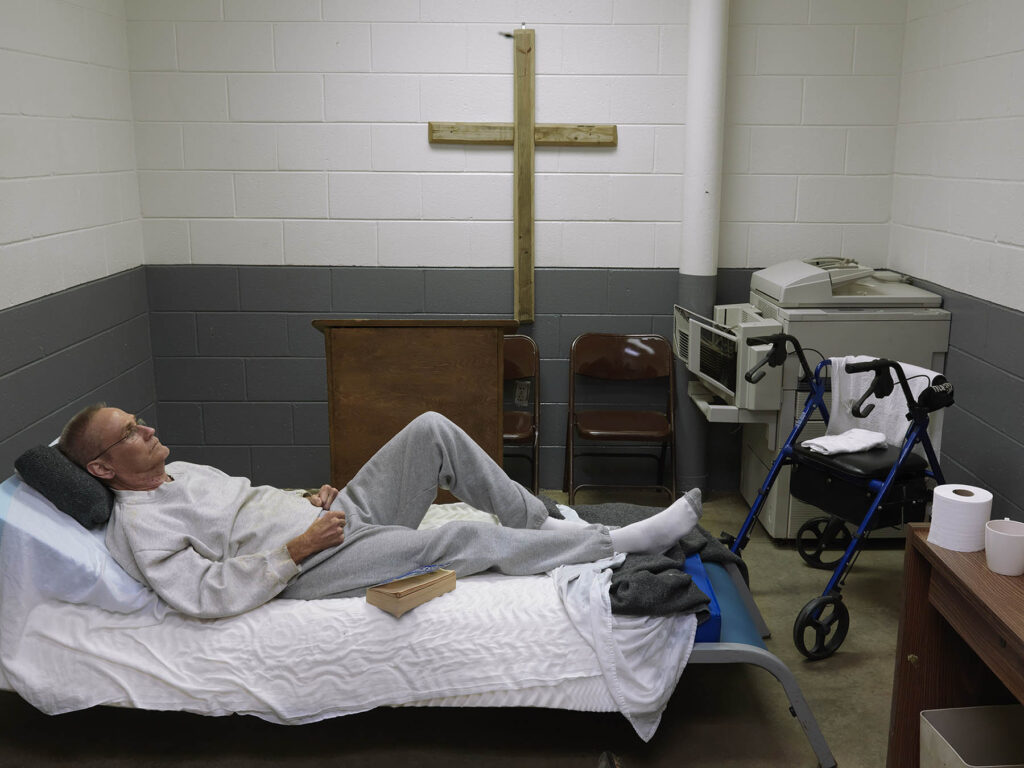The United States has the highest imprisonment rate in the world. While the total U.S. correctional population (probation, parole, prison, jail) decreased in 2012 for the fourth consecutive year, in 2013, it increased slightly. At the end of 2012, the incarceration rate in the United States was 707 for 100,000 inhabitants; every fifth detainee was awaiting trial. There are enormous regional differences with regard to incarceration rates. In 2013, for example, there were 847 prisoners for every 100,000 inhabitants in Louisiana but only 148 in Maine; Georgia was in eighth highest place, with 533 prisoners per 100,000. The estimated occupancy level of prisons in the United States in 2011 was 99.0%; occupancy of Georgia state prisons in 2013 was 105.7%, down from 107.1% in 2011. In 2012, just under 54% of sentenced state prisoners in the United States were serving time for violent crimes, such as homicide, robbery, rape, or assault and battery; just under 19% were serving time for property crimes; and 16% were serving time for drug crimes. In Georgia, 53,279 persons were incarcerated in October 2014 (down from 54,526 the previous year): 49.8% were incarcerated for violent crimes, 15.8% for sex crimes, 18.8% for property crimes, and 11.3% for drug crimes. Reform advocates including the attorney general of the United States would like to see a reduction in the length and predominance of prison sentences, as they are often disproportional and far too expensive.
The nation’s homicide rate fell to 4.5 per 100,000 U.S. inhabitants in 2013, its lowest level since 1963. Much of the decline was in the nation’s largest cities (population one million or more), where the homicide rate dropped from a high of 35.5 per 100,000 in 1991 to 11.9 per 100,000 in 2008. Georgia’s homicide rate, which varied from 8.0 to 15.0 per 100,000 in the 1980s, has not reached the double digits since 1993. Hovering below 6.0 per 100,000 beginning in 2009, Georgia’s homicide rate in 2013 was 5.5 per 100,000 inhabitants. In the years 2007–2015, seven states abolished the death penalty. Nevertheless, capital punishment still exists in 31 states. The United States carries out more executions than any other liberal democracy in the world: 35 people were executed in 2014, down from a high of 98 in 1999. With 58 executions since 1976 (as of Oct. 28, 2015), Georgia is sixth on the list of states that have carried out the most executions since 1976. Of those executed, 37 were white males, one was a white female, and 20 were black males. Five executions involved a black victim or victims; 53 executions involved a white victim or victims. Since 1976, the highest number of executions carried out in Georgia in one year was five (in 1987). As of October 1, 2015, there were 73 men under a sentence of death in Georgia prisons.
The sentence most frequently imposed in the United States is the custodial sentence. The most serious custodial sentence is life imprisonment, which can be imposed with or without the possibility of parole. A life sentence without the possibility of parole really means a sentence for life: persons with such a sentence stay in prison until they die. Sentences to a so-called term of incarceration range from a few months to hundreds of years. Most persons incarcerated in the United States are held in state (not federal) facilities. In 2013, a sentence of imprisonment was imposed on 87.6% of all offenders convicted in federal court; in addition, monetary fines were imposed in 8.5% of all cases, and restitution to be paid to the victim of the crimes was ordered in 14.2% of cases in which the offender was an individual (not an organization). 153 federal offenders were sentenced to life imprisonment; one was sentenced to death. In 2006, the last year for which such statistics are available, the penalty imposed on persons convicted of felonies in state courts was a period of confinement (69%), probation (27%), or another type of sentence, such as fines, community service, or treatment (4%). Also, some 38% of all sentenced persons were ordered to pay a fine as part of their sentence, some 25% of property offenders were ordered to make restitution, and 23% of offenders convicted of drug possession were sentenced to treatment. 0.3% of all sentenced persons were sentenced to life in prison. 120 persons sentenced in state courts in 2006 received the death penalty (this number fell to 68 in 2014).
In Georgia, parole-eligible offenders serving life sentences for drug offenses are eligible for parole consideration after seven years; offenders serving a life sentence for one of the “seven deadly sins” (murder, rape, aggravated sodomy, aggravated child molestation, aggravated sexual battery, armed robbery, or kidnapping) are not considered for parole until they have served 30 years; and offenders serving consecutive life sentences, one of which is for murder, may have to serve up to 60 years before becoming eligible for parole consideration. In the United States, women prisoners are sometimes chained to their beds while giving birth. In 2011, 13 states broadly prohibited shackling inmates during labor and delivery, and anti-shackling bills had been introduced in ten more states. A bill introduced in the Georgia legislature that would have broadly prohibited the use of restraints (including handcuffs and shackles) on Georgia inmates during labor, delivery, and post-delivery recovery failed to pass by the end of the 2014 legislative session. Incarceration of defendants with mental disabilities is rampant. A study published in 2006 found that more than half of all prison and jail inmates in the United States had mental health problems; among female inmates, almost three-quarters had a mental disorder. According to the study, only one in three state prisoners and only one in four federal prisoners with mental health problems had received mental health treatment since admission. Each jurisdiction in the United States has its own statute that establishes the standard for determining whether a defendant was legally insane, and therefore not responsible, at the time the crime was committed. In Georgia, for example, a person who, at the time of the crime, did not have the mental capacity to distinguish between right and wrong in relation to that offense cannot be convicted of a crime; in addition to a possible verdict of “not guilty by reason of insanity”, Georgia’s fact-finders (judge or jury) have the option of finding defendants “guilty but mentally ill” or “guilty but mentally retarded”. While it receives a great deal of publicity, the insanity defense is rarely raised and even more rarely successful. The few defendants found not guilty by reason of insanity are usually subject, more or less automatically, to civil commitment. In 2002, the United States Supreme Court prohibited the sentencing to death and the execution of mentally retarded offenders (Atkins v. Virginia).
In most states, criminal courts have original jurisdiction over individuals who were 18 or older at the time the alleged offense was committed, and juvenile courts have original jurisdiction over individuals alleged to have committed a criminal law violation before reaching the age of 18. In some instances, however, in a number of states and in the federal system, juveniles younger than 18 can be tried in adult criminal court. The lowest age of criminal capacity for the purpose of juvenile court delinquency proceedings differs from state to state. While the majority of states has not specified a minimum age, in the 16 states that have done so, the minimum age ranges from 6 to 10 years. States with no statutory minimum may rely on the common law: 0 to 6 years, no capacity; 7 to 13 years, presumed no capacity (rebuttable); 14 and above, criminal capacity. In Georgia, the minimum age of criminal responsibility is 13.
The United States Supreme Court has made a number of important decisions regarding juvenile offenders in the last ten years: in 2005, it held that only persons 18 or older at the time the capital offense was committed can be sentenced to death (Roper v. Simmons); in 2010, it prohibited sentences of life without the possibility of parole for juvenile offenders convicted of non-homicide offenses (Graham v. Florida); and in 2012, it prohibited mandatory sentences of life without the possibility of parole for juvenile offenders convicted of homicide (Miller v. Alabama). However, most states still allow juveniles convicted of homicide to be sentenced to life without the possibility of parole if the sentence is not the result of a mandatory statute. According to a 2013 publication, approximately 2,500 juveniles were still serving a sentence of life without the possibility of parole; an additional 7,892 persons were serving life sentences with the possibility of parole for offenses committed before they turned 18.
Emily Silverman




















